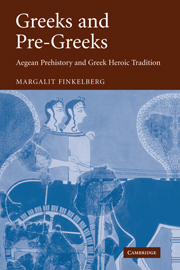Book contents
- Frontmatter
- Contents
- List of maps
- List of figures
- Preface
- List of abbreviations
- Chapter 1 Introduction
- Chapter 2 The heterogeneity of Greek genealogy
- Chapter 3 The pre-Hellenic substratum reconsidered
- Chapter 4 Kingship in Bronze Age Greece and Western Asia
- Chapter 5 Marriage and identity
- Chapter 6 The spread of the Greek language
- Chapter 7 The end of the Bronze Age
- Chapter 8 Continuities and discontinuities
- Appendix: The Testament of Hattusili
- List of references
- Index of passages cited
- General index
Chapter 6 - The spread of the Greek language
Published online by Cambridge University Press: 22 September 2009
- Frontmatter
- Contents
- List of maps
- List of figures
- Preface
- List of abbreviations
- Chapter 1 Introduction
- Chapter 2 The heterogeneity of Greek genealogy
- Chapter 3 The pre-Hellenic substratum reconsidered
- Chapter 4 Kingship in Bronze Age Greece and Western Asia
- Chapter 5 Marriage and identity
- Chapter 6 The spread of the Greek language
- Chapter 7 The end of the Bronze Age
- Chapter 8 Continuities and discontinuities
- Appendix: The Testament of Hattusili
- List of references
- Index of passages cited
- General index
Summary
APPROACHING THE GREEK DIALECTS
‘The question of the interrelationship of the Greek dialects’, Carl Darling Buck wrote in 1907, ‘has an unceasing attraction, not only to the grammarian, but to every student of Greek history. For it always has held and will continue to hold the first place in any discussion of early Greek tribal relations.’ The reason is obvious: the way in which the Greek dialects are distributed in the historic period shows beyond doubt that this situation could not have been the original one. Even a casual look at the dialect map of historic Greece makes it clear that something went wrong (Map 3). Of the so-called Aeolic dialects, Boeotian and Thessalian are found in Greece but Lesbian in Asia Minor only; Attic-Ionic and Arcado-Cyprian, as is indicated by their names, are also split by the Aegean; Doric is wedged in between Arcadian on the one hand and Attic on the other, and Doric and Northwest Greek between Arcadian and the Aeolic dialects. ‘Migration would certainly give rise to the dialect geography we observe’.
- Type
- Chapter
- Information
- Greeks and Pre-GreeksAegean Prehistory and Greek Heroic Tradition, pp. 109 - 139Publisher: Cambridge University PressPrint publication year: 2006



